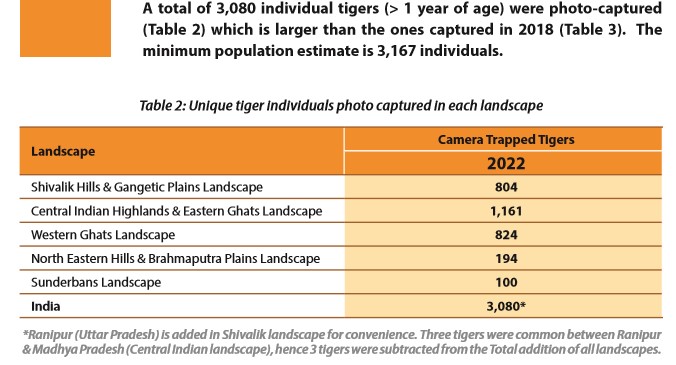Tiger Census 2022
2023 APR 17
Preliminary >
Environment and Ecology > Species extinction & protection > Species in news

Why in news?
- The Prime Minister of India has released the figures of the 5th cycle of India’s Tiger Census 2022, revealing 6.7% in the increase in the past four years.
- The tiger census covered forested habitats in 20 states of India. Camera traps were set up at 32,588 locations and generated 47,081,881 photographs.
About Tiger Census:
- The national tiger census is conducted once every four years.
- The nation-wide tiger census was earlier held in 2006, 2010, 2014, 2018.
Conducted by:
- The National Tiger Conservation Authority (NTCA) conducts tiger censuses in partnership with state forest departments, conservation NGOs, and the Wildlife Institute of India (WII).
How the census is conducted?
- Double sampling based on ground-based surveys and actual images captured on camera-traps.
- Double sampling method was introduced in 2006 after the “pugmark” surveys were found to be inaccurate.
- In 2018 census, 83% of the big cats censused were individually photographed using camera traps.
- In Phases 1 & 2, ground-based surveys were carried out by Forest Department officials to collect signs of tiger presence like scat and pugmarks.
- In phase 3, the information was plotted on the forest map prepared with remote-sensing and GIS (MSTrIPES).
- In the last phase, data were extrapolated to areas where cameras could not be deployed.
Highlights of the 2022 Census:
- Population:
- Population has grown by 200 from 2018 to 2022.
- The current tiger population in India is 3,167 (as of 2022).
- Growth Rate:
- The growth rate slowed to 6.7% in the four years from 2018 to 2022, from around 33% during 2014-2018.
- Increase:
- There has been a significant increase in the tiger population in the Shivalik Hills and Gangetic Plains, while tiger occupancy in Jharkhand, Odisha, Chhattisgarh, and Telangana showed a decline.
- The North East Hills and Brahmaputra Plains had 194 tigers captured by camera traps, and the region’s Nilgiri cluster is the largest tiger population in the world, contributing significantly to colonisation of tigers in neighbouring areas.
- Decline:
- Tiger occupancy in the Western Ghats declined, the latest analysis showed.
- Significant declines were observed in the Wayanad landscape and in the Biligiriranga Hills.
- Decline in tiger occupancy was also observed outside the protected areas of Anamalai-Parambikulam complex.
- Although the tiger populations in the Periyar landscape remained stable, the tiger occupancy has declined outside Periyar.
- High Conservation Priority:
- The genetically unique and small population of tigers in Simlipal is also highlighted as being of high conservation priority.
- The report calls for ecologically viable economic development and trans-boundary tiger conservation strategies to sustain isolated populations.
- Threat:
- The wildlife habitats (Protected Areas and corridors) within this region (Central Indian highlands and Eastern Ghats) face a range of threats:
- Habitat encroachment
- Illegal hunting of both tigers and their prey
- Conflicts between humans and wildlife
- Unregulated and illicit cattle grazing
- Excessive harvesting of non-timber forest produce
- Human induced forest fires, mining
- Ever-expanding linear infrastructure.
- This region is also having several mines of important minerals, hence mitigation measures like lower mining impact techniques and rehabilitation of mining sites should be done on priority.
States with the highest population of Tigers in India
- Madhya Pradesh >> Karnataka >> Uttarakhand >> Maharashtra >> Tamil Nadu
PRACTICE QUESTION
Consider the following statements regarding ‘National Tiger Census’ in India:
1. It is conducted once every four years
2. It is conducted by National Tiger Conservation Authority
Which of the statements given above is/are correct?
(a) 1 only
(b) 2 only
(c) Both 1 and 2
(d) Neither 1 nor 2
Answer
